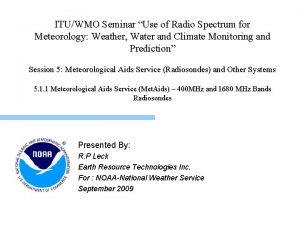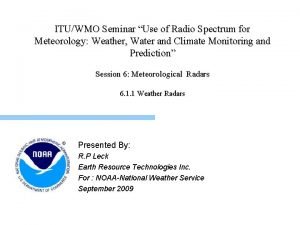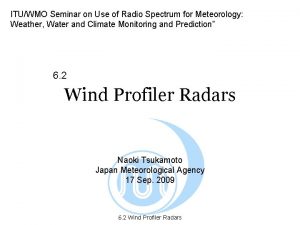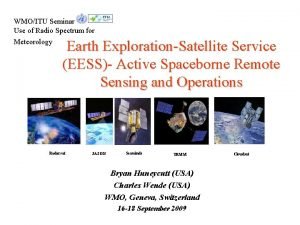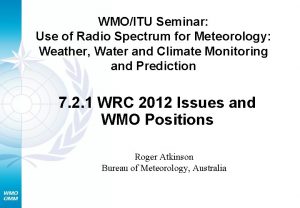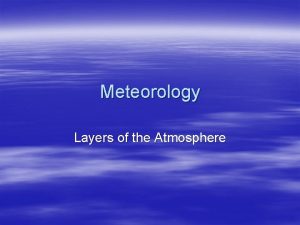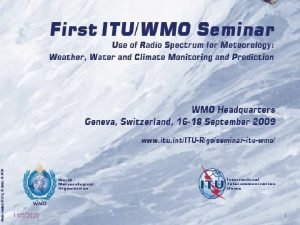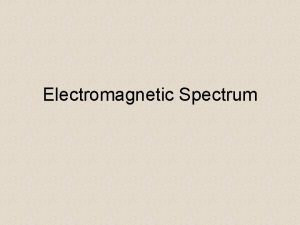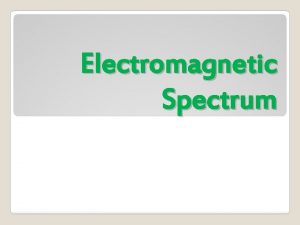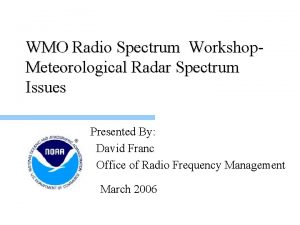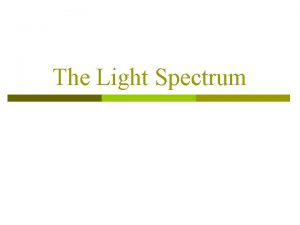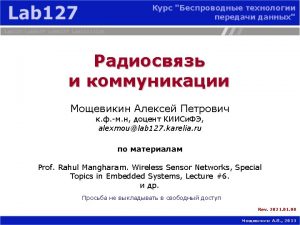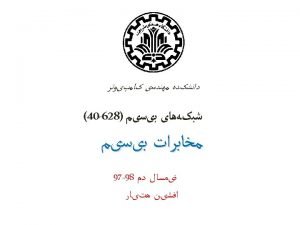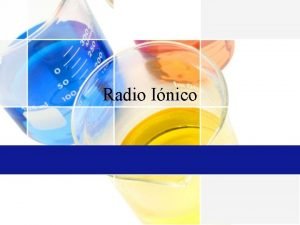ITUWMO SEMINAR USE OF RADIO SPECTRUM FOR METEOROLOGY

































- Slides: 33

ITU/WMO SEMINAR "USE OF RADIO SPECTRUM FOR METEOROLOGY” WEATHER, WATER AND CLIMATE MONITORING AND PREDICTION (WMO, GENEVA, SWITZERLAND, 16 -18 SEPTEMBER 2009) ITU Role in the efficient use of orbit/spectrum for meteorological/ environmental/ space remote sensing systems Yvon HENRI Chief, Space Services Department ITU/BR International Telecommunication Union

ITU in brief Committed to Connecting the World Ø Founded on 17 May 1865 Ø 191 Member States, > 700 Sector Members & Associates Ø 750 staff / 70 nationalities ØAnnual budget = $140, 000 Øhttp: //www. itu. int Ø ITU is the leading UN agency for information and communication technologies

ITU Key priorities Committed to Connecting the World • radio spectrum • international standards • emergency communications • climate change monitoring • digital divide • cybersecurity 3

ITU Mission Committed to Connecting the World “To ensure rational, equitable, efficient and economical use of the radio frequency spectrum by all radiocommunication services including those using the geostationary satellite orbit or other satellite orbits - and to carry out studies on radiocommunication matters” 4

Committed to Connecting the World § United Nations Outer Space Treaty (1967) Outer space free for exploitation and use by all states in conformity with international regulations States retain jurisdiction and control over objects they have launched into outer space

Committed to Connecting the World § United Nations Outer Space Treaty (1967) § International Telecommunication Union Principles of use of orbit/spectrum Allocation of frequency bands Procedures, Plans, operational measures Instruments (CS, CV, RR, Ro. Ps, Recs)

Committed to Connecting the World GSO SATELLITES INTERFERENCE Non-GSO SATELLITES TERRESTRIAL STATION TRANSMITTING EARTH STATION RECEIVING EARTH STATION

Committed to Connecting the World Propagation of Radio waves • Laws of physics • Radio waves do not stop at national borders Interference • possible between radio stations of different countries • This risk is high in Space Radiocommunications Radio Regulations (RR) • One of its main purposes - Interference-free operation of Radiocommunications

Committed to Connecting the World Radio Regulations Mechanisms Control of Interference ALLOCATION POWER LIMITS Frequency separation of stations of different services PFD to protect TERR services / EIRP to protect SPACE services / EPFD to protect GSO from Non-GSO REGULATORY PROTECTION e. g. No. 22. 2: Non-GSO to protect GSO (FSS and BSS) COORDINATION between Administrations to ensure interference-free operations conditions

Committed to Connecting the World Radio Regulations - Lengthy & complex procedure Decided by Administrations during WRC Governed by: -More sophisticated use of spectrum -Individual requirements of administrations Trend towards simplification / improvement to certain procedures

Committed to Connecting the World Radio Regulations - Lengthy & complex +Efficient use of procedure spectrum +Equitable access +Opportunity to resolve interference before operation +Prevents loss of investment, customers & revenue by minimizing unusable capacity due to interference 11

Committed to Connecting the World Radio Regulations • Rights & obligations + applicable procedures • Two mechanisms of sharing orbit / spectrum: Coordination Approach Planning Approach Efficiency Û First come, first served for actual requirements Equitable access Û Plan for future use 12

Committed to Connecting the World Efficient & Rational Utilization Article 9 (Sect. I, II) (Coordination procedure) App. 4 App. 5 Article 11 Exchange of information (Notification procedure) Article 21, 22 (Limits) Procedural Approach Objectives Res 49 Coordination … 13

Committed to Connecting the World Radio Regulations (RR) • The international rights and obligations of the Administrations in respect of their own satellite systems and of other administrations’ frequency assignments are derived from the recording of their assignments in the MIFR. • Such rights, and in particular the international recognition, are conditioned by the provisions of the Radio Regulations 14

Radio Regulations - 3 Committed to Connecting the World Status RIGHT for international recognition OBLIGATION to eliminate harmful interference Art 7 -8 Frequency TABLE & Monitoring Art 4 -6 AP 9 -10 (9 k. Hz-275 GHz) Procedures Coordination, Notification & Recording Interference Art 15 -16 Limits technical/operational Arts 21, 22 Apps 1 -3 Art 9, 11 AP 4 -8 Definitions – Art 1 -3, AP 14, 42 Administrative Secrecy/Licences/ Interception/Identification of stations/ call signs/Service Publications Art 17 -20 Bureau & RRB – Art 13 -14 Services Aeronautical – Art 35 -45 Maritime – Art 46 -58 Amateur, broadcasting, fixed, radiodetermination, standard freq. & time - Art 12, 23 -29 AP 11 -13, 16, 19 Plans Maritime HF, VHF (AP 17 -18) Maritime coast stations (AP 25) Aeronautical (OR) (AP 26) Aeronautical (R) (AP 27) Broadcasting-satellite (AP 30 -30 A) Fixed-satellite (AP 30 B) GMDSS Art 30 -34 MIFR AP 15 (Master Register) 15

Committed to Connecting the World ART 5 frequency allocations § No. 5. 2 - For the allocation of frequencies the world has been divided into three “radiocommunication” Regions 16

Committed to Connecting the World ART 5 frequency allocations § A frequency band can be allocated to more than one service (PRIMARY or secondary), either on a worldwide or Regional basis § No. 5. 28 - Stations of a secondary service: Ø 5. 29 - shall not cause harmful interference to stations of primary services …; Ø 5. 30 – can not claim protection from harmful interference from stations of a primary service …; Ø 5. 31 - can claim protection, however, from harmful interference from stations of the same or other secondary service(s) …. § A footnote to a frequency band or service may include a restriction on the service or services concerned Ø to operate in a particular country (ies) Ø not causing harmful interference to another service Ø not claiming protection from another service 17

Committed to Connecting the World Radio Regulations and Sensors § No. 1. 182 active sensor: A measuring instrument in the earth exploration-satellite service (EESS) or in the space research service by means of which information is obtained by transmission and reception of radio waves. § No. 1. 183 passive sensor: A measuring instrument in the earth exploration-satellite service or in the space research service by means of which information is obtained by reception of radio waves of natural origin.

Committed to Connecting the World Remote Sensing (1) • Remote sensors are the only tools that provide environmental data on a long term, repetitive and GLOBAL scale. • Radiocommunication systems based on remote sensing play the major role in weather and climate prediction. • Remote sensing is the essential tool for disaster prediction, detection, disaster mitigation and planning of relief operations. • Sensors are used for detection and tracking of earthquakes, tsunamis hurricanes, typhoons, floods, fires, oil leaks, dangerous pollution, etc.

Committed to Connecting the World Remote Sensing (2) • Remote sensors are the basis of meteorological and Earth exploration-satellite services. • Operated in the main by governments and international agencies (NASA, ESA, CNES, ISRO, NOAA, METEOSAT, etc) • Data collected by active and passive sensors are distributed worldwide in the Global Observing System (GOS) and used to benefit humanity as a whole. • Remote sensing data are frequently disseminated through other radiocommunication systems belonging to the fixed-satellite service as well as other services.

Committed to Connecting the World WRC and Remote Sensing (1) • WRCs regularly consider remote sensing requirements for allocation of additional frequency bands, sharing with other services, protection from interference, etc. • WRC-07 considered (with positive results) 4 main issues directly related to remote sensing: Ø extension of band for active sensors; Ø extension of band for meteorological-satellite service; Ø sharing between Earth exploration-satellite service (EESS) (passive) and active services; Ø protection of EESS (passive) from unwanted emission from actives services.

Committed to Connecting the World WRC Remote Sensing (2) § WRC-07 also approved 5 Resolution and specific § • • • Agenda items for the next WRC-11 on the use and further development of remote sensing systems: These Resolutions are related to: use of optical links for remote sensing; development of systems for lightning detection; use of high-frequency oceanographic radars for measurement of coastal sea surface conditions; further development of the meteorological-satellite systems operating near 8 GHz; use of radiocommunications for Earth observation

Committed to Connecting the World WRC and Remote Sensing (3) § The relevant Agenda items in connection with Remote Sensing are as follows for WRC-12 § 1. 6: frequencies between 275 and 3 000 GHz: passive or active? § 1. 8: regulatory issues relative to the fixed service between 71 and 238 GHz (protection of the passive band 86 -92 GHz) § 1. 22: effect from Short Range Devices (SRD), impact on ALL radiocommunication services

Committed to Connecting the World Use of the EESS Passive Sensors § Microwave observations at frequencies below 100 GHz enable studies of the Earth’s surface and its atmosphere from spaceborne instruments even in the presence of clouds, because clouds are almost transparent at these frequencies. This "all-weather" observing capability has been very important for EESS in achieving the repetitive global coverage mandatory for meteorological, climatological, and environmental monitoring and surveying. § The impressive progress made in recent years in weather analysis, warning and forecasts, especially for dangerous weather phenomena that affect all populations and economies is largely attributable to the spaceborne observations and their assimilation in numerical models. § Play a major role in the prediction and detection of disasters.

Committed to Connecting the World Passive Sensors observe through the atmosphere

Committed to Connecting the World EESS Passive sensors - Frequency bands Typical bands and their main application: § 1 400 -1 427 MHz: salinity (ocean), soil moisture (ground) § 10. 6 -10. 7 MHz: rain, snow, ice, sea state, ocean wind § 23. 6 -24 GHz: total content of water vapour § 31. 3 -31. 5 GHz: the lowest cumulated effects due to oxygen and water vapour in the vicinity of the 50 GHz band. Optimum window channel to see the Earth’s surface: reference for the other channels. § 36 -37 GHz: cloud liquid water, vegetation structure, surface roughness § 50. 2 -50. 4 GHz: temperature profile

Committed to Connecting the World Microwave Spectrum Spectral Sensitivity to Environmental Parameters: Land Surface

Committed to Connecting the World Microwave Spectrum Spectral Sensitivity to Environmental Parameters: Ocean Scene

Committed to Connecting the World Envisat SORCE Aura/Aqua/Terra Sage Quik. Scat IKONOS CBERS Sea. Wi. FS SPOT 4, 5 SPIN-2 Sea. Winds TRMM Orbview 2, 3 DMC ACRIMSAT EROS A 1 ERBS Radarsat ALOS Toms-EP Quick. Bird Grace UARS Jason Landsat 7 EESS Observation Systems

Committed to Connecting the World Global Observing System (GOS)

Committed to Connecting the World EESS (passive) Application Remote Sensing Key Applications -1 § Weather Prediction: a key input to numerical weather prediction models used globally for weather forecasting. § Global Warming: concentrations and distributions of atmospheric gases, sea and land ice thickness and change, and ozone measurements are key components to studying and prediction of global warming. § Significant Weather Events: the prediction of dangerous weather events requires accurate measurements of rain rates in storms over the oceans which is only possible with remote sensing EESS. § Forest Fires: detection of fires through smoke by their microwave radiation.

Committed to Connecting the World EESS (passive) Application Remote Sensing Key Applications -2 § Management of Natural Resources: measurements of biomass, deforestation, and water resources through systematic environmental monitoring. § Volcanoes: used to detect volcanic activity even before eruptions and to track and predict the volcanic fallout effects. § Shipping: used to track sea ice, ice floes, and ocean storms to steer ships out of harm’s way. § Long Range Climate Forecasts: study of global atmospheric and oceanic events such as El Niño requires sea surface temperature, ocean winds, ocean wave height, and many other components used in the prediction of long range weather forecasting and climatic trends.

ITU Role in the efficient use of orbit/spectrum for meteorological/ environmental/ space remote sensing systems Questions ? Yvon HENRI Chief, Space Services Department ITU/BR International Telecommunication Union
 Line spectrum and continuous spectrum difference
Line spectrum and continuous spectrum difference Absorption spectrum
Absorption spectrum Light spectrum frequency
Light spectrum frequency Conventional radio system
Conventional radio system Fspos vägledning för kontinuitetshantering
Fspos vägledning för kontinuitetshantering Typiska novell drag
Typiska novell drag Tack för att ni lyssnade bild
Tack för att ni lyssnade bild Returpilarna
Returpilarna Varför kallas perioden 1918-1939 för mellankrigstiden?
Varför kallas perioden 1918-1939 för mellankrigstiden? En lathund för arbete med kontinuitetshantering
En lathund för arbete med kontinuitetshantering Adressändring ideell förening
Adressändring ideell förening Tidböcker
Tidböcker A gastrica
A gastrica Densitet vatten
Densitet vatten Datorkunskap för nybörjare
Datorkunskap för nybörjare Tack för att ni lyssnade bild
Tack för att ni lyssnade bild Hur skriver man en tes
Hur skriver man en tes Delegerande ledarskap
Delegerande ledarskap Nyckelkompetenser för livslångt lärande
Nyckelkompetenser för livslångt lärande Påbyggnader för flakfordon
Påbyggnader för flakfordon Formel för lufttryck
Formel för lufttryck Publik sektor
Publik sektor I gullregnens månad
I gullregnens månad Presentera för publik crossboss
Presentera för publik crossboss Jiddisch
Jiddisch Vem räknas som jude
Vem räknas som jude Treserva lathund
Treserva lathund Luftstrupen för medicinare
Luftstrupen för medicinare Claes martinsson
Claes martinsson Centrum för kunskap och säkerhet
Centrum för kunskap och säkerhet Programskede byggprocessen
Programskede byggprocessen Mat för idrottare
Mat för idrottare Verktyg för automatisering av utbetalningar
Verktyg för automatisering av utbetalningar Rutin för avvikelsehantering
Rutin för avvikelsehantering


































